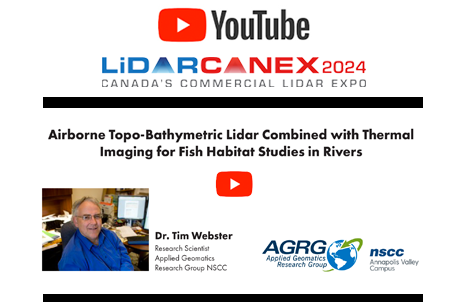Airborne Topo-Bathymetric Lidar Combined with Thermal Imaging for Fish Habitat Studies in Rivers from LiDAR CANEX 2024
Dr. Timothy Webster, a Research Scientist at the Applied Geomatics Research Group (AGRG) based at Nova Scotia Community College’s Annapolis Valley Campus, recently presented research at Lidar CANEX 2024. The presentation is on the use of airborne Topo-Bathymetric Lidar combined with thermal imaging for fish habitat and fish passage studies in rivers.
Nathan Kroll, Thomas Allen, Kevin McGuigan, Kevin Ferris, and Lauren Douglas, with several other researchers, have contributed to the analysis and interpretation of various datasets in this research work. For nearly a decade, he and his team have been at the forefront of using the airborne Leica Chiroptera 4X (CH4X ) topo-bathymetric lidar sensor to survey coastal, riverine, and lake environments. Their focus has been on mapping submerged aquatic vegetation (SAV), a critical aspect of aquatic ecosystems.
To understand Topo Lidar’s world, Dr. Webster provided insights into its applications in hydrology. The D8 algorithm, employed on a high-resolution DEM, facilitates the derivation of flow direction, flow accumulation, and the creation of synthetic stream networks. Additionally, the system calculates stream order and longitudinal profiles, enabling the identification of steep sloping areas, as well as the analysis of the riparian zone using digital surface models.
Leica Chiroptera 4X system uses lasers and a camera to collect data for Topo-Bathymetric Lidar surveys. The data collected can be used to derive water depth, longitudinal profiles, bedforms, and hydrodynamic models. The Topo-Bathymetric Lidar-derived River network is more accurate than hydrographic networks derived from photogrammetry. The accuracy of the data collected is within 15 cm, allowing for precise analysis of river features and fish habitat. The collected data can be integrated with thermal imagery from drones for further enhancement of fish habitat studies.
Dr. Webster presented the application of topo-bathy lidar data in rivers for enhancing flood hazard hydrodynamic models and analyzing fish habitat and passage. By leveraging the capabilities of the CH4X system, which provides seamless land-riverbed DEM, RGB, and NIR orthophotos, researchers can calculate water depth from the water surface and DEM. This integrated approach is useful for understanding river systems, aiding in habitat assessment and flood risk management.

Source: https://www.youtube.com/watch?v=VuQ9lhwVJsA&list=PLChc04GPgeTQ5_Qc4cIh4zI4bGxap640z&index=1
In a recent development, the team has combined this lidar data with RPAS (drone) thermal imagery using the DJI M300 RTK system equipped with the H20T thermal and RGB camera. The thermal imagery serves to identify the location of ‘cold’ springs, which serve as vital refuges for fish during the summer months. By overlaying this thermal data with the lidar-derived streambed bathymetry and depth information, researchers gain valuable insights into fish habitat distribution and dynamics.
The summit of this analysis equips river stewardship groups with the insights needed to plan and execute restoration projects effectively. By identifying impediments to fish passage and understanding the complex interactions between habitat characteristics and thermal conditions, stakeholders can make informed decisions to promote the health and sustainability of river ecosystems. In conclusion, Dr. Webster’s presentation stresses the transformative potential of integrating advanced geospatial technologies, lidar, and thermal imaging in river research and management.




